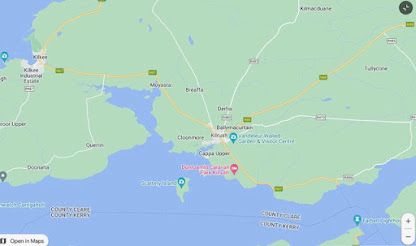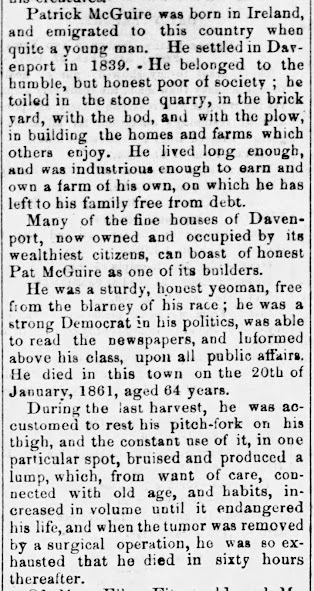Just in time for St. Patrick's Day, I'm back with a blog post about one of our ancestors named Patrick. I will focus on Patrick McGuire* (1797-1861) and I think you will not be disappointed by this remarkable Irish immigrant. For those of you (like my sister) who like to position ancestors around Felicite Constant Motier, Patrick was the father of Felicite's daughter-in-law, Mary McGuire Motie. In fact, Patrick almost surely interacted with Felicite in Davenport.
Patrick was born in Kilrush, County Clare, a far western part of Ireland (also where the Keatings and the Creaghs come from later).
Patrick immigrated to the U.S. with his wife, Margaret Slattery, and two older daughters, Mary (1828) and Catherine (1834). He arrived in Davenport in 1839 and I think he left Ireland a year or two early and went through Newfoundland on the way to Davenport. Again, we have no specific information about why he came to Iowa, but the "pull" was likely jobs and opportunities.
There are two unusual aspects of Patrick's immigration. First, he came with a wife and family. After the famine, it was more common for family members to go one at a time, but Patrick came with his wife and daughters. Second, Patrick immigrated before the big Irish famine in 1847. I like to think Patrick was a bit ahead of his time!
After arriving in Davenport, Patrick and Margaret had four more children, Richard (1841), Margaret Matilda (1842), Peter (1845) and Michael (1847).
Again, we have no specific information about what Patrick did when he first arrived in Iowa, but he must have been hard-working. His obituary tells us that he worked in a variety of jobs, including a brickyard and a stone quarry. He also farmed, the obituary states that McGuire ended up owning his own farm which he left to his family "free from debt."
At some point, he must have met our other ancestor, Joseph Motie, because McGuire's eldest daughter, Mary, marries Joseph Motie in 1847 at age 15. McGuire's children all seem to do well socioeconomically. Richard becomes a police officer in Davenport and Margaret Matilda marries another French Davenporter, Frank Huot.
Here is Patrick's obituary printed in the Davenport Daily Democrat and News Feb. 23, 1861.
In addition to the weird description of his fatal pitch-fork thigh injury, I think it's interesting to see the deep anti-Irish sentiments. The obituary states that he belonged to the "humble, but honest poor of society." But, through hard work, he climbed the societal ladder. It reads, "He was a sturdy, honest yeoman, free from the blarney of his race." It is also interesting that Patrick seemed to have some level of literacy, namely being able to read a newspaper.
Anti-Irish sentiments were very prominent in 19th Century America. Here is an example of an anti-Irish poster from the late 19th century.
We do not have any photos of Patrick (nor paintings), but we do have a photo of his daughter, Mary McGuire Motie, with a child, most likely her oldest daughter Margaret. (I found this photo on ancestry, I don't own it).
So, Happy St. Patrick's Day, let's raise a toast to our many Patricks this year, but certainly a special shout out for Patrick McGuire!
*McGuire is sometimes spelled Maguire and it some records he's shown as John Patrick, but I think he dropped the John in the U.S.
Thanks to my mom and dad for proof reading this blog, Mary Ann Baker for a hard copy of McGuire's obituary, and Tammy Eledge for helping me find a digital copy of that article.





very nice compilation of the Maguire family. kudos to Catherine Keating for your diligent ancestry work!
ReplyDeleteMore wonderful history to absorb. The right ancestor to honor for this upcoming St. Patrick's Day! The stained glass picture of the saint is beautiful. My parents always kept a statue of St. Patrick in our home.
ReplyDeleteAnother ancestor with a fascinating story. Your selections for your blog are so interesting and their journeys so difficult. What stamina our ancestors had to make better lives for themselves and their families! Thank you for another fine post, including all the pictures you are able to include, Catherine.
ReplyDeleteSorry, the post above, 9/8/24 at 2:37 p.m. is from me.
Delete